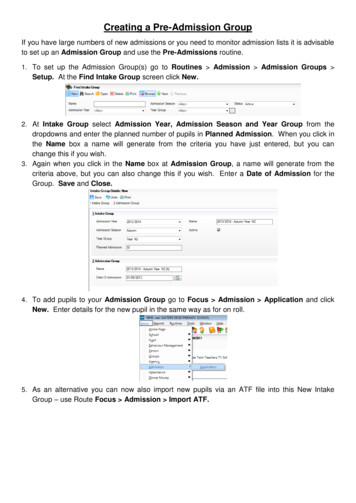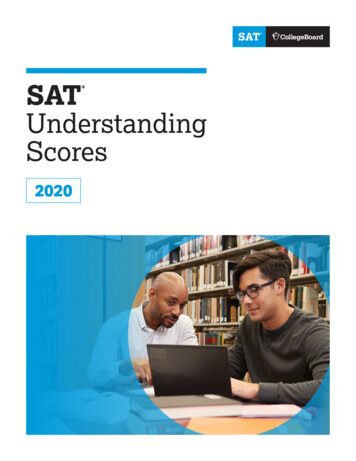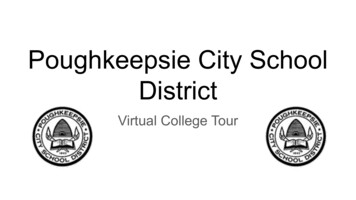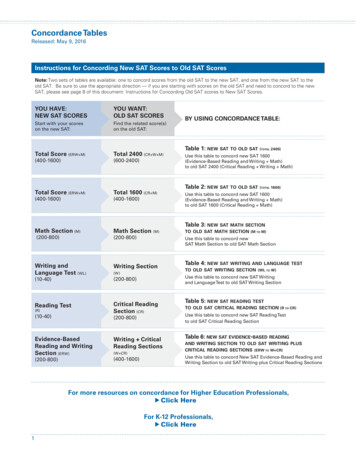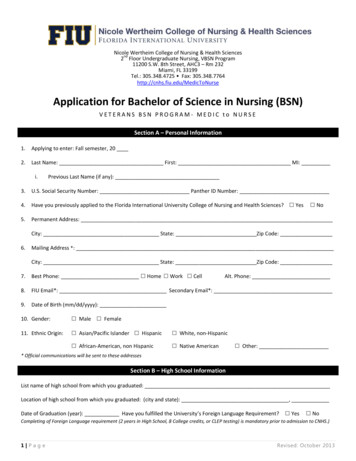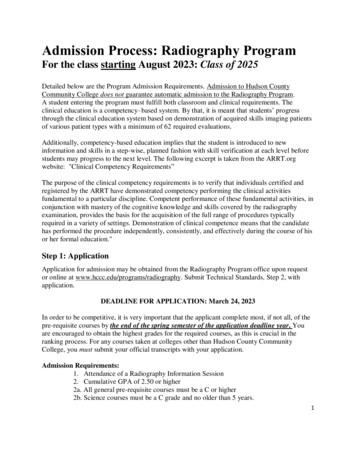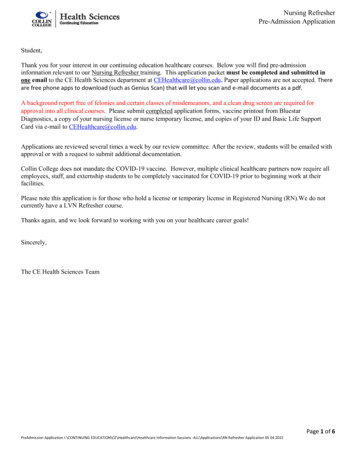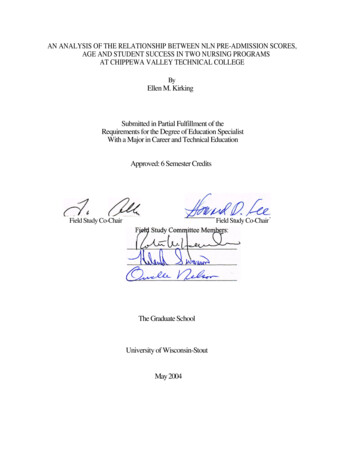
Transcription
AN ANALYSIS OF THE RELATIONSHIP BETWEEN NLN PRE-ADMISSION SCORES,AGE AND STUDENT SUCCESS IN TWO NURSING PROGRAMSAT CHIPPEWA VALLEY TECHNICAL COLLEGEByEllen M. KirkingSubmitted in Partial Fulfillment of theRequirements for the Degree of Education SpecialistWith a Major in Career and Technical EducationApproved: 6 Semester CreditsField Study Co-ChairField Study Co-ChairThe Graduate SchoolUniversity of Wisconsin-StoutMay 2004
The Graduate SchoolUniversity of Wisconsin-StoutMenomonie, Wisconsin 54571ABSTRACTKirkingEllen(Last Name)(First)M(Initial)AN ANALYSIS OF THE RELATIONSHIP BETWEEN NLNPRE-ADMISSION SCORES, AGE AND STUDENT SUCCESS IN TWONURSING PROGRAMSAT CHIPPEWA VALLEY TECHNICAL COLLEGE(Title)Career and Technical EducationMr. T. Allen, Dr. H. Lee(Graduate Major)(Research Co-Advisors)May, 200483(Month/Year)(#of Pages)American Psychological Association, 5th edition(Name of style manual used in this study)The current shortage of nurses, along with a need to decrease attrition rates isrequiring that schools of nursing examine their admission policies. The purpose of thisstudy was to explore the relationship between scores obtained by students on the NationalLeague for Nursing Pre-Admission Examination for Registered Nurses (NLN PAX-RN)and their level of success in an Associate Degree or Practical Nursing Programs.Correlation studies of students’ scores on the four areas of the PAX-RN and coursegrades attained in several required nursing and science courses that most strongly revealdifferences in student performance were done. Multiple regression studies furtherexplored which combinations of factors analyzed were the best predictors of studentsuccess in their Anatomy and Physiology (A&P) course. Additionally, student success,as further defined by completion of the Associate Degree Nursing Program and
NLN PAX RN iiicompletion of the Practical Nursing Program was compared with scores attained on thePAX-RN.The results of this study supported use of the PAX-RN as a valid and reliablepredictor of student success. The Composite and Verbal components of the examinationwere strongly correlated to student success in selected nursing and science courses. Agewas also examined as a variable associated with student success. In this study, olderstudents tended to score higher on the PAX-RN and to have higher course grades in all ofthe selected courses.As a result of this study, the college’s nursing department will use theinformation gathered to modify their admission policies. The information can also beused to improve advisement and counseling of students, and to implement measures tofurther support students within the program.
NLN PAX RN ivAcknowledgementsI would like to thank a number of people who assisted me towards completion ofthis project. I would like to thank my research committee, Dr. Bob Hendricks, Dr. OrvilleNelson, and Dr. Helen Swanson for all of their many contributions. I would especiallylike to thank Tom Allen for his statistical knowledge and skill. He definitely knows myweakness in statistics. I would also like to thank Dr. Howard Lee for his additionalguidance and direction in this project. Additionally, I would like to thank Dr. Amy Gillettfor her assistance in getting me started on this project in Research Foundations.Finally, I would especially like to thank my family for their support in thisjourney. I know that there were times when I would have rather been doing somethingelse other than writing this paper or working with my numbers. My husband Dan, and mythree children, Adam, Kiersten and Meghan have tolerated my need for the computer, tohave them finish the laundry, or to rely on someone other than me for rides. The end ofthis journey is over. I thank you all.
NLN PAX RN vTABLE OF CONTENTSList of Tables .Chapter One Introduction .Statement of Problem . Research Purpose . .Research Questions . .Significance of Study . Assumptions and Limitations. Definitions of Terms . .Methodology . . Chapter Two Review of Literature .Overview of the Health Care Crisis Impact of Crisis on Schools of Nursing .Demographic Variables .Admission Criteria and Success . .Admission Criteria and NCLEX .Summary . Chapter Three Methodology . Subject Selection and Description . Research Method Data Collection .Instrumentation .Data Processing and Analysis Limitations. . .Summary Chapter FourResults . .PAX-RN and Program Completion .PAX-RN and A&P .PAX-RN and Introduction to Nursing .PAX-RN and Pharmacology .PAX-RN and Pathophysiology .PAX-RN, Course Grades and Age .Chapter FiveDiscussion, Conclusions, Recommendations. .Findings .Discussion of Findings .Conclusions. .Limitations .Recommendations .Impact for Chippewa Valley Technical College Further Research . .Summary References .Appendix A Tables of Further Statistical Analysis 4546474949505657585965666975
NLN PAX RN viLIST OF TABLESTable 1Table 2Table 3Table 4Table 5Table 6Table 7Table 8Table 9Table 10Table 11Table 12Table 13Table 14Table 15Table 16Table 17Table 18Table 19Nursing Program Retention Rates .Comparison of Nursing Graduates and Non-Completers Equality of Means for Associate Degree and Practical Nursing Students.Range of PAX-RN Test Scores Graduates Scoring 50th Percentile .Correlations Between Nursing and A&P Courses .T-Test for Equality of Means- Course Grades .Multiple Regression Analysis: Age, PAX-RN and A&P ANOVA for PAX-RN Scores and Age as Predictors for A&P .A Comparison of Ages, PAX-RN and Grades .PAX-RN, Nursing Courses and Age .Significant Correlations: PAX-RN and Courses. Analysis of NLN PAX-RN Scores: T-test .Comparisons of Various Coefficients . .Composite Scores 50th Percentile . Composite Scores 35th Percentile . NLN Percentile Scores .Independent Samples Tests on Means .Regression Analysis in the Prediction of A&P Course Grades .4373839404141434448767778787980818283
NLN PAX RN 1CHAPTER IIntroductionThe health care industry is at a critical point. An aging health care workforce,coupled with the expanding baby boomer population, increased career options forwomen, and a growing dissatisfaction among health care workers have contributed to ashortage of trained employees in the health care industry (Mee & Robinson, 2003; O’Neil& Seago, 2002; Berliner & Ginzberg, 2002).The shortage of health care workers has caused schools of nursing to questiontheir admission and acceptance policies (Fischer, 2003b; Williams, 2002; Bissett, 1995).Although some schools of nursing are experiencing a reduction in students seekingadmission, other schools are faced with the daunting task of dealing with a growingnumber of students desiring entry into their programs (Woodards, 2003; Willaims, 2002;Swain, 1999). Many of these students have been identified as being ill prepared forcollege and for the demands of nursing, a profession that requires that graduates useknowledge acquired from various science, sociology, psychology, and nursing classes tomake important decisions about increasingly more critical and complex patient caresituations (Lewis & Lewis, 2000; McClelland, Yang, & Glick, 1992; Allen, Higgs, &Holloway, 1988). When students are unprepared for the rigors of a nursing program,academic failure can occur. These student setbacks can be expensive financially for thestudent and the college, and can lead to difficulty with student reentry back into thecurriculum (Byrd, Garza & Nieswiadomy, 1999). These setbacks are very ego deflatingfor students and distressing for nursing faculty working with the students (Fischer, 2003a& b; Lengacher & Keller, 1990). Gallagher, Bomba, and Crane (2001) concluded, “The
NLN PAX RN 2growing shortage of nurses compels schools of nursing to admit students who are mostlikely to graduate and subsequently pass NCLEX-RN” (p. 135).As a result of long waiting lists at some schools, many well-qualified students areunable to get into a nursing program, or to become nurses who would ease the health careworker shortage. The high cost of nursing education, along with limited funding for theseprograms, a growing number of under-prepared students, and restrictions on availabilityof clinical sites and nursing instructors, have forced many programs to resist thetemptation to expand. Despite the need to keep enrollments high to ensure an increasednumber of nursing graduates, schools are also burdened with attrition rates that can behigher than 40% in some schools of nursing (Community College Week, 2000). Withgrowing waiting lists and the need to prepare students who will both graduate and passthe licensure examination upon completion of their program, schools of nursing havebeen examining their admission requirements and exploring ways to increase the level ofsuccess for those students who are admitted (Ostryre, 2001). A variety of methods arecurrently being used to determine eligibility for admission at schools of nursing aroundthe country. These methods include standardized tests, interviews, evaluation of astudent’s high school or pre-program grade point average, and a determination of thestudent’s ability based on achievement in science courses.The Nursing Program at Chippewa Valley Technical College (CVTC) offerspractical nursing and associate degree nursing programs. The National League forNursing-Accreditation Commission (NLN-AC) has accredited both programs. Theassociate degree program has grown from admitting 40 associate degree nursing (ADN)students twice a year prior to fall, 2002 at the Eau Claire, Wisconsin campus to the
NLN PAX RN 3current level of admitting 56 students twice a year to the campus in Eau Claire, and anadditional 16 students annually at the River Falls, Wisconsin campus. The college alsoadmits a number of licensed practical nurses (LPN’s) who are returning to school toobtain their associate’s degree in nursing. These students may or may not be graduates ofCVTC’s practical nursing program. Currently, these students do not take the PAX-RNexamination prior to enrollment into the second year of the Associate Degree NursingProgram.The college also admits twenty-four practical nursing students twice a year in EauClaire and twenty-four annually in River Falls. These students are not required to take thePAX-RN examination for admission, although many graduates of the practical nursingprogram have taken the test in anticipation of admission to the associate degree-nursingprogram. Additionally, a number of students who were initially admitted to the associatedegree-nursing program elect to switch to the practical nursing program for varyingreasons, including lack of success in the two-year program.Programmatic growth has occurred in response to local and state pressures toincrease admissions in an attempt to produce more nursing graduates. Unfortunately,despite program growth and the establishment of a mentoring program for many of thenew students admitted beginning in fall, 2002, attrition rates remain high for the ADNprogram, leading one to question whether locally, the trend towards under-preparedstudents is also being seen (See Table 1).
NLN PAX RN 4Table 1Nursing Program Retention Rates at Chippewa Valley Technical 7%58%(CVTC NLNAC Self Study 2000; Program Data 2002)Students admitted to the associate degree program for nursing at Chippewa ValleyTechnical College have taken the NLN Pre-Admission Examination for RegisteredNurses (PAX-RN) since 1995. Students entering the program in advanced standing (LPNto ADN students) do not need to take this examination because it has been determinedthat these students have already demonstrated a certain level of academic achievement.Additionally, other students entering the associate degree program for nursing at CVTCmay be waived from the admission-testing requirement if they have taken othercomparable college admission tests, or if the student who presents has already attained abachelor’s degree in another field.CVTC has established a standard of achievement on the PAX-RN at the 50thpercentile for each of the three subject areas (mathematics, science and reading) and forthe composite score on the examination. As of fall 2003, any student who obtains acomposite score less than the 35th percentile on the PAX-RN will be denied admissioninto the associate degree-nursing program. In addition, any student who does not attain ascore the 50th percentile in any of the four areas needs to meet with a programcounselor to develop a remediation plan. All components of the remediation plan must becompleted before the student is accepted into the associate degree-nursing program. Thestudent can take these courses while enrolled as a pre-program student at the college. The
NLN PAX RN 5remedial course work is designed to increase the likelihood of student success in theprogram. Currently, students are not retested after remediation is completed to determineif the process has increased their likelihood of success. A number of the students tested todate with the PAX-RN have chosen to enter the practical nursing program at the collegeor have transferred into the practical nursing program after initial enrollment in theassociate degree program.Student retention rates at CVTC are lower than desired. The nursing program hasidentified a need to explore ways to increase student success. Despite use of the PAX-RNsince 1995, to date, a comprehensive analysis to determine the relationship betweenstudents’ success within the nursing program and PAX-RN scores has not formally beenconducted. A preliminary analysis in Spring 2003 by Ellen Kirking for a subgroup ofstudents who had taken the examination strongly suggested that students’ success waslinked to the scores they attained on the PAX-RN, and prompted the researcher’s desireto analyze more extensively students’ scores and level of success attained. Furtherevaluation is necessary to enable the nursing department to both increase student successand student retention.Statement of the ProblemThe current nursing shortage combined with budgetary constraints and ongoingconcerns about retention of students requires that the nursing department at ChippewaValley Technical College collect data concerning students’ PAX-RN scores. The findingsof this study will enable the department to objectively examine their admission policiesand explore ways to better utilize the PAX-RN to decrease attrition and increase studentsuccess.
NLN PAX RN 6Research PurposeThe purpose of this study is to validate the relationship between students’ PAXRN scores and their level of success in a nursing program. Although graduates of theCVTC associate degree-nursing program have a passing rate of approximately 87% andgraduates of the practical nursing program had a 93% passing rate as first time test takerson the NCLEX examination, (NCSBN, 2003) retention of students remains less thandesired for both programs. By collecting and comparing data from all students who havetaken this examination from November 1995 through May 2002 with student outcomes,the nursing program will be able to both counsel prospective students on their likelihoodof success, and to develop interventions intended to increase retention and graduationrates.Research QuestionsThere are seven research questions this study will attempt to answer. They are:1. What is the relationship between students’ scores on each of the four PAX-RNexaminations (mathematics, science, reading and composite score) andcompletion of the associate degree- nursing program?2. What is the relationship between students’ scores on each of the four PAX-RNexaminations and completion of the practical nursing program?3. What is the relationship between students’ scores on each of the four PAX-RNexaminations and course grades obtained in Anatomy and Physiology I?4. What is the relationship between students’ scores on each of the four PAX-RNexaminations and course grades obtained in Introduction to Nursing?
NLN PAX RN 75. What is the relationship between students’ scores on each of the four PAX-RNexaminations and course grades obtained in Pharmacology?6. What is the relationship between students’ scores on each of the four PAX-RNexaminations and course grades obtained in Pathophysiology?7. Is there a difference between NLN PAX-RN test scores and grades obtained inselected nursing and science courses for older students and younger students?Significance of the StudyThe results of this study will provide the nursing department with objective datathat will be used to validate preliminary findings done in spring 2003 by this researcherthat strongly suggested a relationship between students’ scores on the NLN-RN preadmission examination and students’ level of success within the nursing program. Thedata obtained will be inclusive of students who have taken the examination from 1995 toMay 2002. The data will focus on students who have completed A&P or their firstsemester nursing courses. The results of the study may assist the nursing faculty andcounselors at CVTC to more effectively use these scores to counsel prospective studentsdesiring admission into the nursing program. The results may also enable the program todevelop intervention strategies targeted at identified student deficits to increase retentionrates, thereby increasing student success throughout the program. Due to the currentshortage of nurses and other health care workers, combined with the higher than desiredattrition rates, an overwhelming number of students desiring program entry, and thefinancial cost of failure, the nursing department needs to collect data immediately thatcould lead to increased student success.
NLN PAX RN 8AssumptionsThe following assumptions have been identified with this study:1. The data will be inclusive of all students who took the NLN-RN preadmission examination from 1995 through May 2002.2. Students included in the study will have completed at least their first semesterof nursing classes at CVTC.3. Grades recorded for students’ science and selected nursing courses are anaccurate representation of ability.4. Students who leave or do not complete the program do so in poor academicstanding.5. Being accredited by the National League for Nursing - AccreditationCommission (NLNAC) will not influence the CVTC nursing program’sevaluation of the NLN PAX-RN as a predictor of student success.LimitationsThe following limitations have been identified with this study1. Those CVTC nursing students who took alternative forms of pre-admissiontests and advanced placement students will not be included in the data.2. The study is primarily focused on the associate degree-nursing program atChippewa Valley Technical College, although students who completed thepractical nursing program will also be included.3. A comparison will be done between NLN PAX-RN scores and only selectedcourses within the curriculum.
NLN PAX RN 94. The variables to be analyzed are limited to scores obtained on students’ PAXRN test and letter grades in A&P I and selected nursing courses.5. Any grade inflation that might have occurred in students’ course grades willbe unknown.6. Students may have left the nursing program for reasons other than academicstanding (morbidity).Definition of TermsThere will be five terms that will be defined for clarity of understanding. These termsare:1. Associate degree-nursing students: Students enrolled in a two-year programof study leading to an associate degree in nursing. Graduates of this programqualify to take the National Council Licensure Examination (NCLEX-RN).Candidates who pass the NCLEX-RN earn the credentials to be registerednurses (CVTC Associate Degree Nursing Program Student Handbook, 2004).2. NLN pre-admission examination- RN (PAX-RN): The National League forNursing pre-admission examination is a standardized examination that testsprospective students’ verbal, mathematics, and science abilities. Theexamination provides nurse educators with an appraisal of students’ academicabilities (NLN, 2003c).3. Older student: Students over the age of 30.4. Practical nursing students: Students enrolled in a one-year program of studyleading to a diploma in nursing. Graduates of this program qualify to take theNational Council Licensure Examination (NCLEX-PN). Candidates who pass
NLN PAX RN 10the NCLEX-PN earn the credentials to be licensed practical nurses. (CVTCPractical Nursing Program Student Handbook, 2004).5. Student success: Student success will be defined using a leveled approach.The following criteria will apply:a. Successful completion of first semester class (Introduction to Nursing510-110).b. Successful completion of second semester class (Pharmacology 510-130).c. Successful completion of third semester class (Pathophysiology 510-122).d. Completion of the associate degree-nursing program (successfully passing510-171 Nursing Practice Internship).e. Completion of the practical nursing program (successfully passing 510306 Clinical Concepts for the Practical Nurse).MethodologyAn ex post facto study will be conducted using archival data that is available to theresearcher in her role as program director. Data that will be collected will includestudents’ scores on the PAX-RN examination beginning in 1995. Additionally, gradesobtained in selected nursing courses and A&P will be collected. Comparisons betweenthe students’ PAX-RN scores and their course grades will be determined. Furthercomparisons between the selected science and nursing course grades will also beanalyzed. Finally, the variable of age will be introduced to determine if a difference existsin level of performance for students both on the PAX-RN and in the selected nursing andscience courses.
NLN PAX RN 11CHAPTER IIReview of LiteratureIntroductionThis chapter will include an overview of the current health care crisis, and adiscussion of the effects of the crisis on schools of nursing. Various demographicvariables that have been examined as predictors of success and admission criteria used byschools of nursing will be described, along with an in-depth presentation of the NationalLeague for Nursing pre-admission examination for registered nurses’ (NLN PAX-RN)test. In addition, previous findings concerning the use of various admission criteria indetermining students’ level of success within nursing programs and success on theNational Council Licensure Examination for Registered Nurses (NCLEX-RN) andNational Council Licensure Examination for Practical Nurses (NCLEX-PN) will beaddressed.Overview of the Health Care CrisisA shortage of workers is creating new demands on the health care industry. Withestimated shortages of registered nurses (RN’s) projected to be affecting as many as 44states including Wisconsin by 2020 (HRSA, 2002), health care agencies and schools ofnursing are examining what they can do to minimize the severity of the problem.An aging workforce, declining enrollments at many nursing programs prior to2002, and dissatisfaction on the job have contributed to the nursing shortage. The averageage of practicing RN’s is 45.2 years (Berlinger & Ginzberg, 2002), and more than 27,000fewer students took the NCLEX-RN examination in 2001 than in 1995 (AACN, 2003)
NLN PAX RN 12The national sample survey of registered nurses is conducted every four years todetermine the current supply and projected demand for registered nurses in the UnitedStates. The study, last conducted in 2000, found the demand for registered nurses hasrisen dramatically. In addition, the current and future supply of RN’s is projected to beinadequate to meet the needs of an aging population, with some states anticipating asmany as 14% fewer RN’s than needed by 2010 (HRSA, 2002).Impact of the Health Care Crisis on Schools of NursingIn response to the shortage of health care workers, schools of nursing across thecountry have been challenged to admit and to graduate more nursing students. Manycolleges and universities have seen a growing number of students who are seekingadmission into their nursing programs. At least 2.9% of all college bound studentsexpressed an interest in nursing, making it one of the more popular fields of study(Auerbach & Buerhaus, 2000). In Wisconsin, however, as in other states, students oftenfind themselves on a waiting list to get into a nursing program along with 300-500 otherstudents, and may have to wait for three years or longer before they are able to secureadmission into one of these nursing programs (Williams, 2002).Associate degree nursing programs traditionally offer students the ability tocomplete their nursing degree in two or three years, or a year or two quicker thanattending a baccalaureate program. Practical nursing programs allow students to completetheir programs of study in less than two years. The number of associate degree nursingprograms has risen dramatically in the last forty years, from 57 programs in 1960 to 876programs in 1997 (Auerbach & Buerhaus, 2000). A majority of these programs arelocated in community and technical colleges.
NLN PAX RN 13With growing waiting lists and limited resources, many community collegeschools of nursing across the country have been forced to re-evaluate their “open door”policy, a concept initiated in the 1960’s in response to the GI Bill and massive numbersof “baby boomers” entering higher education (Bissett, 1995). Theoretically, the opendoor policy allows all students to have open access to enter any educational programoffered at the college with students admitted on a first-come, first-served basis.The dilemma occurs, however, because students are often ill prepared for theacademic rigors of a nursing program (Fischer, 2003a; Lewis & Lewis, 2000). Withdwindling financial support and attrition rates climbing, colleges are questioning ifprospective students should have access to rigorous programs for which they may not bewell suited. In addition, despite pressures to expand, schools of nursing are mandated byregulatory agencies to maintain low faculty-to-student ratios during clinical experiencesand to hire nurses for instruction who are credentialed minimally at the master’s degreelevel. Schools of nursing must also ensure that their graduates are prepared to pass thenational licensure examination and be able to work as “safe, competent practitioner(s)”(Allen, Higgs, & Holloway, 1988, p. 113).Comparison of Various Demographic Variables as Predictors of Success Within aNursing Program and on the Licensure ExaminationA variety of demographic variables have been examined as possible determiners ofstudent success in the nursing program. Age has been cited in many studies with varyingdegrees of correlation seen. Lengacher and Keller (1990) found a subject’s age uponadmission into the nursing program was not predictive of the graduate’s success on theNation Council Licensure Examination for Registered Nurses (NCLEX-RN). Other
NLN PAX RN 14studies also reported similar conclusions (Jenks, Selekman, Bross & Paquet, 1989; Allen,Higgs & Holloway, 1992).In a comprehensive ten-year review of predictors of retention, graduation andsuccess on the licensure examination, Campbell and Dickson (1996) identified that agewas found to be the most significant demographic predictor of student success with olderstudents more likely to demonstrate success than younger students. These authors alsofound that financial status and parental educational level were more closely correlatedwith success on the licensure examination than any other demographic variables, and thatself-esteem and level of test anxiety also correlated with success in these baccalaureatenursing students.Age was also examined as a predictor of students’ success in a nursing program,graduates’ success on the state board examination, and as it related to ACT test scores forstudents admitted to an associate degree nursing program over a ten year period of time(Aldag & Rose, 1983). These researchers found, while a larger percentage of youngerstudents were admitted into the program, a higher percentage of those in the older agegroup (30-39) actually graduated and did better on the state board examination. They alsofound a negative correlation between students’ ages and ACT scores with bias seenagainst the older, nontraditional student. The authors did not identify any possibleexplanation to support their findings.In a contrasting study, Byrd, Garza and Nieswiadomy (1999) found that youngerstudents had a higher level of success than older students enrolled in a baccalaureatenursing program. The researchers also identified that white ethnicity was highlypredictive of students’ graduation, but they acknowledged that a higher percentage of
NLN PAX RN 15white applicants had been admitted to this nursing program than other ethnic groups dueto their high pre-admission GPA.In another study prompted by concerns related to a decline in academicqualification for students entering a baccalaureate-nursing program, researchersexamined the impact of forty academic and non
Nursing Program Retention Rates at Chippewa Valley Technical College 1998-1999 48% 1999-2000 49% 2000-2001 47% 2001-2002 58% (CVTC NLNAC Self Study 2000; Program Data 2002) Students admitted to the associate degree program for nursing at Chippewa Valley Technical College have taken the NLN Pre-Admission Examination for Registered
